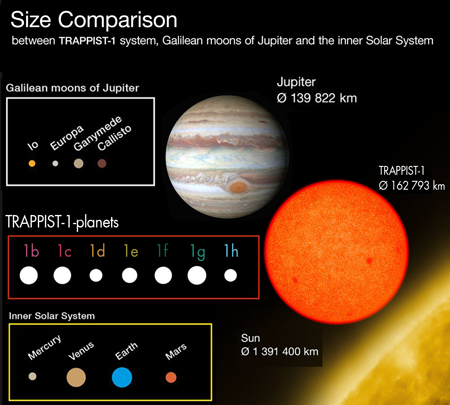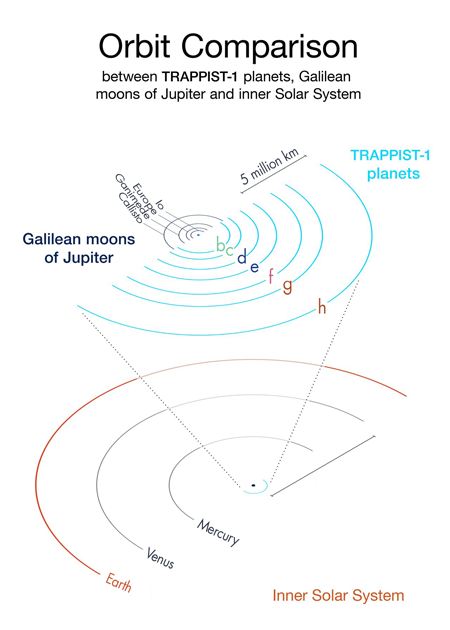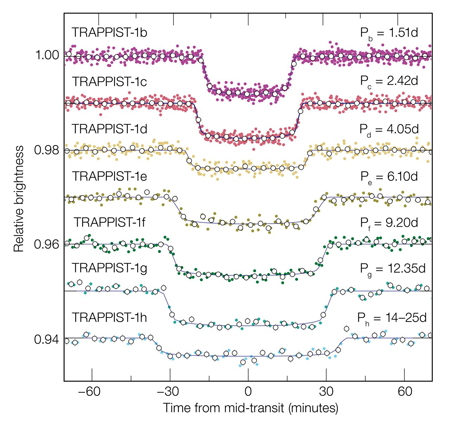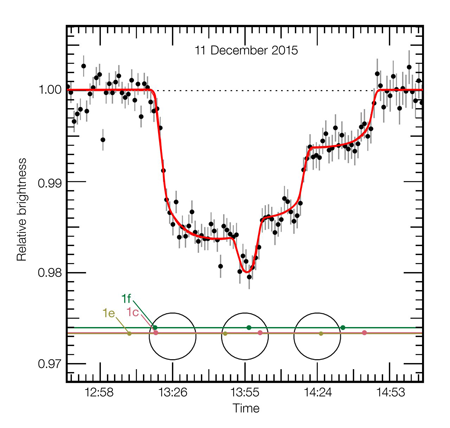iKon-L CCD camera from Andor helps discover new exoplanet system TRAPPIST-1
An international team of astronomers under Dr. Michaël Gillon from the Institute of Astrophysics and Geophysics of the University of Liege has discovered a planetary system around TRAPPIST-1. It is only 40 light years away and has at least seven earth-sized planets. This discovery was supported by an Andor CCD-camera iKon-L 936 which features a high-sensitivity Back Illuminated Deep Depletion CCD sensor.TRAPPIST-1 is very small and dim red dwarf in the constellation Aquarius. It has only about 8% of our sun’s mass and is only slightly larger than Jupiter, the largest planet in our solar system. Due to its low energy output, which is about 250.000 times weaker than that of the sun, TRAPPIST-1 can only be observed with large telescopes.

Fig. 1: Size comparison of the TRAPPIST-1 planets with bodies from the solar system. All planets found around TRAPPIST-1 are nearly earth-sized. Source: ESO/O. Furtak
Already in 2016, astronomers using the TRAPPIST-South telescope on the premises of the European Southern Observatory (ESO) in La Silla in Chile had discovered three terrestrial planets in the TRAPPIST-1 system. Now 7 earth-sized terrestrial planets have been found by using NASA’s Spitzer space telescope, the ESO’s Very Large Telescope VLT, the Belgian TRAPPIST-South and TRAPPIST-North telescopes and observatories on Hawaii, La Palma and in South Africa. Three of them orbit around their host star at a distance which suggests the possibility of liquid water on the surface. This means the three exoplanets TRAPPIST-1e, f and g are potential candidates for extraterrestrial life. At the moment, TRAPPIST-1 is the exoplanetary system with the largest number of rocky, terrestrial, potentially habitable planets.
Accidentally, the TRAPPIST-1 planets orbit their host directly in our line of sight. Viewed from Earth we can see that the planets pass their host star in regular intervals and dim it (transit). By using this data, it is possible to calculate the orbits, diameters, and masses of the planets (transit method).

Fig. 2: Comparison of the TRAPPIST-1 system with the inner solar system and the Galilean moons of Jupiter. All planets around TRAPPIST-1 are subject to similar radiation as Venus, Earth and Mars and even for the outermost planet TRAPPIST-1h, one year takes onlay approx. 20 days. Source: ESO/O. Furtak
All seven orbits are very close to their host star. The innermost planet TRAPPIST-1b only needs 1.51 days for one full revolution and event the outermost planet TRAPPIST-1h only needs 1 year and approx. 20 days. Their orbital radii lie between 0.011 and 0.06 astronomical units. One astronomical unit is the medium distance between earth and sun (approx. 149.6 million km). The seven TRAPPIST-1 planets’ masses range from 0.62 to 1.38 earth masses and their diameters vary between 0.76 and 1.13 earth radii.
In addition to the TRAPPIST program the astronomers of the University of Liège also have the SPECULOOS (Search for habitable planets eclipsing ultra-cool stars) project to find exoplanets. During the SPECULOOS project, four iKon-L CCD-cameras will look for habitable planets around red dwarfs in our stellar neighborhood. Future projects like the European Extremely Large Telescope (E-ELT) or the James-Webb-Space-Telescope will be able to examine in detail the atmospheres of these exoplanets and find possible traces of extraterrestrial life.
Find further information on the TRAPPIST-1 system and the search of the astronomers for habitable exoplanets:
[1] Gillon et al., Seven temperate terrestrial planets around the nearby ultracool dwarf star TRAPPIST-1, Nature, February 2017
[2] Julien de Wit et al., A combined transmission spectrum of the Earth-sized exoplanets TRAPPIST-1 b and c, Nature, 20 July 2016
[3] Gillon, E. Jehin, et al., Temperate Earth-sized planets transiting a nearby ultracool dwarf star, Nature, May 2016
[4] TRAPPIST (TRAnsiting Planets and PlanetesImals Small Telescope):
http://www.trappist.ulg.ac.be
[5] SPECULOOS (Search for habitable Planets eclipsing ultra-cool stars):
http://speculoos.ulg.ac.be
[6] Press release of the University of Liège:
http://thema.ulg.ac.be/spatial/sept-merveilles-de-trappist-1/
Source
Press release of the European Southern Observatory (ESO):
https://www.eso.org/public/germany/news/eso1706/

Fig. 3: Light curves of the seven TRAPPIST-1 planets during their transits. The graph shows how the light of the very small, ultra-cool and dim dwarf TRAPPIST-1 gets weaker while each of the seven known planets passes in front of the star and blocks some of the light. The larger planets cause larger dips in the light output, the planets that are further away have longer transit times, as they revolve at a slower pace. All this data comes from observations with the NASA Spitzer telescope.
Source: ESO/M. Gillon et al.

Fig. 4: VLT observations of the light curve of TRAPPIST-1 during the triple transit of 11 December 2015. The star was observed with the HAWK-I instrument on the VLT of the ESO, as three planets passed in front of the star and blocked its light output. This light curve shows for the first time three temperate Earth-sized planets with moderate climates and two of them in the habitable zone which pass in front of their star.
Source: ESO/M. Gillon et al.
Where does LOT-QD come in?
You can get the cameras used with the TRAPPIST-North telescope and with the SPECULOOS project from us!
By the way, the TRAPPIST-North telescope is located in Oukaïmeden in the Morrocan Atlas mountains at 2750 m with more than 250 clear nights per year. The iKon-L 936 CCD-camera used is particularly suited to discover planets around red dwarfs, because of its special features:
- Very high quantum efficiency of over 90%
- Thermo-electric cooling to -80 °C (air) and -100 °C (water) with very little dark current
- Linearity better 99%
- Extremely low read noise of only 3 electrons
- Scientific-grad CCD sensor with 2048 x 2048 x 13 µm pixels
Contact
| +49 6157 80710-754 | |
| +49 6157 807109754 | |
| Write e-mail |



